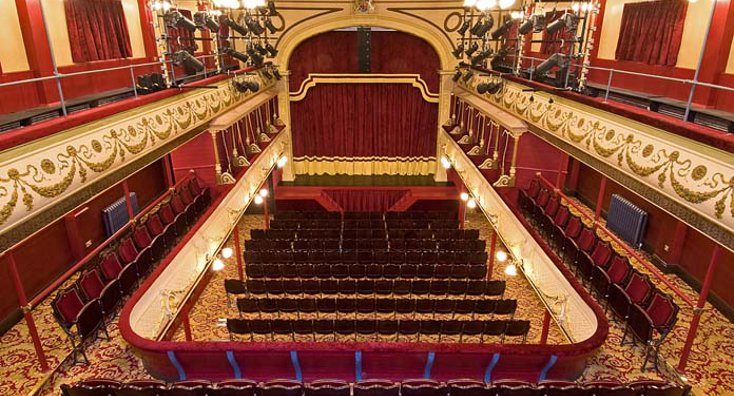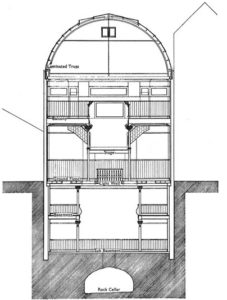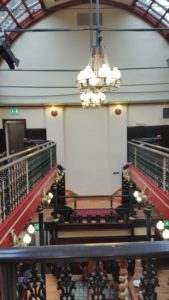News
24 April 2019 / Blogs
Researching Pubs and Music-halls

Photo of the City Varieties, Leeds, by Debs Jeffries
Deborah Jeffries received a Research Award in 2018 for her research into Victorian pubs and music-halls. She is working on finding out how and why pubs were the true founders of music hall, with particular reference to the City Varieties, Leeds and the Malt Cross, Nottingham.
As A.E. Wilson wrote in her book East End Entertainment, “it is easy to trace the origins of the music-hall and the later more refined theatres of variety to the old tea gardens and taverns which once flourished in the suburbs and particularly in the eastern fringes of London” (Wilson, 1954, p208). In order to gain an overall picture of early music hall in England from the late eighteenth century onwards for my PhD thesis, ‘Legitimising London’s Victorian Music Hall’, I was granted money by the Society for Theatre Research for travel to Leeds and Nottingham to visit two of the country’s five surviving music halls that are still in use as entertainments venues – City Varieties, Leeds and the Malt Cross, Nottingham. Both venues are excellent examples of what I consider to be or have been a pub music hall; that is a repurposed area within or extension to a public house (inn or tavern) primarily used for the presentation of musical entertainment organised by and with the purpose of making a profit for the proprietor of the establishment.
City Varieties, Leeds is the venue that most people consider to be the epitome of a music hall. It is, but not because of its 1953 incarnation when the first episode of ‘The Good Old Days’ was shown on TV or subsequent restoration to its current glory in 2012, but because it originated in 1766 as a purpose-built singing room above the Swan public house (The Swan opened in 1762). I visited City Varieties in December to coincide with a performance of ‘Cinderella’, last season’s rock’n’roll panto. This was my third visit to the venue. I have previously attended as a regular punter but this time I was treated to an access all areas tour by Stephen Brennan, Education Manager at Leeds Grand Theatre and Opera House Ltd, on behalf of Leeds City Council, which has owned the building since 1987. As anyone who has ever researched a PhD or a book will tell you, what makes all of the hard work and pressure worthwhile are the Eureka moments that hit you from time to time. I had always known that City Varieties was attached to a pub but had, somewhat lazily, thought of it as a variety theatre and so a product of the mid to late 1880s trend towards constructing entertainments venues with fixed seating facing the front. Walking around the building I became increasingly aware that I was standing in what was once a flat floor room with flexible seating and the dual purpose of enabling music entertainment to be enjoyed by patrons and making money for the proprietor by extending the space for eating and drinking. What is now City Varieties is also a very rare and very special example of a surviving eighteenth century pub music hall. Eureka!
 During the same trip I moved on to Nottingham to meet up with Milly Fry, Heritage Coordinator at the Malt Cross. Again, this wasn’t my first visit to the venue. I met Milly a couple of years ago when I joined one of her wonderful tours of the building. In fact, I have used her anecdotes about why men wore tops hats to the music hall on tours of Hoxton Hall and Wilton’s I’ve led as part of Open House London (she claims it was to protect them from being covered in beer and other by-products of too much drinking that came over the balcony). As with City Varieties, this return visit enabled me to ask more targeted questions; armed with knowledge I’d gleaned from my previous trips and other research. Like City Varieties, the Malt Cross originated out of a public house.
During the same trip I moved on to Nottingham to meet up with Milly Fry, Heritage Coordinator at the Malt Cross. Again, this wasn’t my first visit to the venue. I met Milly a couple of years ago when I joined one of her wonderful tours of the building. In fact, I have used her anecdotes about why men wore tops hats to the music hall on tours of Hoxton Hall and Wilton’s I’ve led as part of Open House London (she claims it was to protect them from being covered in beer and other by-products of too much drinking that came over the balcony). As with City Varieties, this return visit enabled me to ask more targeted questions; armed with knowledge I’d gleaned from my previous trips and other research. Like City Varieties, the Malt Cross originated out of a public house.
However, neither Milly’s extensive nor my limited research suggests that it was used for musical entertainment prior to redevelopment as a music hall. The Malt Cross pub was initially called The Roebuck Inn and was first listed in the borough records as “a common alehouse” in 1760.
 The ‘Malt Cross’ was a historic monument at the bottom of St James’s Street, where the venue is situated and where malt was sold. When the monument was pulled down in 1804, the Roebuck Inn was renamed the Old Malt Cross, with the first record of the pub using this name appearing in trade directories from 1815. Prior to being sold at auction in 1876, the Malt Cross hosted many public meetings. It also housed a covered skittle alley, most likely in the basement. After redevelopment complete with the addition of a balcony, the Malt Cross opened as a music hall in 1877. Unlike City Varieties the Malt Cross never became a variety theatre. The flexible seating and tiny, high, ‘top hat’ stage (so called because it was so high you could see the artistes over the top of the punters’ tall hats) are original characteristics which lend themselves more to a pub cafe, which is its main use today.
The ‘Malt Cross’ was a historic monument at the bottom of St James’s Street, where the venue is situated and where malt was sold. When the monument was pulled down in 1804, the Roebuck Inn was renamed the Old Malt Cross, with the first record of the pub using this name appearing in trade directories from 1815. Prior to being sold at auction in 1876, the Malt Cross hosted many public meetings. It also housed a covered skittle alley, most likely in the basement. After redevelopment complete with the addition of a balcony, the Malt Cross opened as a music hall in 1877. Unlike City Varieties the Malt Cross never became a variety theatre. The flexible seating and tiny, high, ‘top hat’ stage (so called because it was so high you could see the artistes over the top of the punters’ tall hats) are original characteristics which lend themselves more to a pub cafe, which is its main use today.
The results of the 2019 Research Awards will be announced at the STR AGM on May 9th – keep an eye on the website!